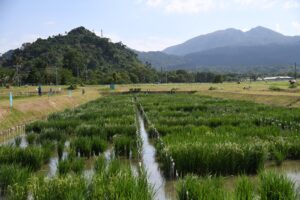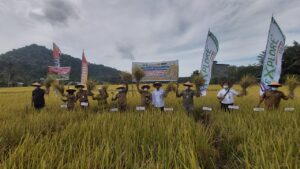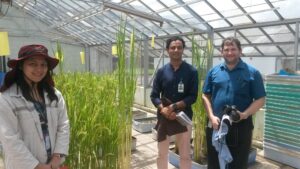It is said that if you want to be a good gardener you should always sow three seeds: one for the bugs, one for the weather, and one for yourself. But if you tell this to Seybou Lema, who produces and sells seeds of the New Rice for Africa (NERICA) in the West African country of Togo, he wouldn’t agree to waste even a single seed.
Seybou doesn’t want to be just a good farmer; he wants to be efficient as well because the happiness of his entire family depends on the quantity and quality of the NERICA seeds he produces. The NERICA varieties, which are bringing hope to millions of poor people in Africa, were developed by the Africa Rice Center (WARDA) and its partners.
“With the money I got from selling NERICA seeds, I bought food, paid school fees for my children, and bought clothes for them,” Seybou said. “I have also used the cash to extend our house,” he added, proudly showing the new extension made of concrete, next to his hut.
Seybou belongs to a new breed of African rice farmers trained in seed production techniques as part of a program on a community-based seed production system (CBSS) that was introduced by WARDA and its partners as an integral part of the NERICA dissemination program.
In sub-Saharan Africa, seed production and distribution are major bottlenecks to the dissemination of new crop varieties. A study conducted by WARDA economists in 2005 found that only about 30% of rice farmers interviewed were growing improved high-yielding rice varieties because of a severe shortage of seed.
The main reason for the seed shortage is that national seed systems lack the staff, equipment, and funding to assure farmers an adequate supply of quality seeds on a regular basis. To overcome this problem, CBSS trains farmers on how to produce good seed for their own use, and to exchange or sell excess seed to other farmers. A major advantage of CBSS is that it shortens the time required for seed of improved varieties to reach farmers.
CBSS-trained farmers, such as Seybou, are now quietly changing the rice scenario in sub-Saharan Africa, where farmers traditionally save, exchange, and use rice seeds from one harvest to the next or, in times of shortage, buy rice paddy from the market to use as seed.
Even for Seybou, it was difficult to accept at first that one could sell seeds. But, when he found out to his great amazement how much money he could make by selling NERICA seeds, he abandoned cotton farming and began to devote all his time, effort, and land to NERICA seed production.
Seybou started NERICA seed production on half a hectare in 2004 and gradually increased the area to 6 hectares in 2006. “But I am still unable to cope with the demand for seed from farmers of neighboring villages,” he told a delegation from the African Rice Initiative.
The African Rice Initiative is particularly interested in NERICA seed production because it was established to scale up the dissemination of NERICA and complementary technologies across sub-Saharan Africa through a coordinated effort. The Initiative has been actively involved in the production of NERICA foundation (basic) seed as well as in the training of extension staff and farmers in seed production, with the support of many partners and donors, including the African Development Bank, Rockefeller Foundation, Japan International Cooperation Agency, and the United Nations Development Programme (UNDP).
In 2005, a US$35 million 5-year project was launched by the African Development Bank to support NERICA dissemination in seven West African countries—Benin, Ghana, Guinea, Mali, Nigeria, Sierra Leone, and The Gambia. About 80% of the targeted beneficiaries of this project, which is coordinated by the African Rice Initiative, are the rural poor, mostly women.
The project estimates that by the 5th year, about 33,000 farm families will be involved in participatory varietal selection, a process in which farmers and breeders work together to choose new varieties best suited to the farmers’ needs (see Taking part on pages 22-26 of Rice Today Vol. 3, No. 2). Many of them will also be involved in CBSS to accelerate NERICA dissemination.
“The African Rice Initiative and WARDA are exploring with relevant partners, particularly the national systems, to put in place sustainable NERICA seed production and delivery strategies,” says Inoussa Akintayo, ARI regional coordinator, who is based at WARDA.
The demand for NERICA seed is not restricted to West and Central Africa. In fact, the biggest surprises are emerging from Uganda, Kenya, and Tanzania in East Africa, where NERICA was introduced just 4 years ago.
NERICA’s potential as a cash crop has captured the attention of Uganda’s seed companies. This is partly explained by the fact that rice is considered more of a cash crop than a food crop in East Africa in contrast to West and Central Africa.
Subsistence farmers are also seeing the positive impact of commercial NERICA seed production in Uganda. “The new rice has changed our living,” says one Ugandan farmer. “Our incomes have increased. We have bought clothes, a house, and a bicycle.”
At present, targeted NERICA seed production and distribution projects across sub-Saharan Africa are supported by many donors and international nongovernmental organizations, including Japan, UNDP, Rockefeller Foundation, the African Development Bank, Canadian International Development Agency, International Fund for Agricultural Development, World Bank, Food and Agriculture Organization of the United Nations, Sasakawa-Global 2000, Centre Songhai, and World Vision International.
To overcome problems of poor rice seed quality and health, an initiative to scale up technology transfer of good seed production techniques using video has been launched by an International Fund for Agricultural Development- funded WARDA project in Mali, Guinea, The Gambia, and Ghana. Rice seed health videos produced by the International Rice Research Institute, CABI, Countrywise Communication, and the Rural Development Academy Bogra in association with rural women in Bangladesh are being shown to African rice farmers to enable them to learn from their Asian colleagues.
“We are getting these videos translated into French and local languages in close association with our national and local nongovernmental organization partners,” says WARDA Technology Transfer Specialist Paul Van Mele. “In Guinea, where NERICA has been widely adopted, these videos have reached thousands of farmers in less than 6 months, contributing to better seed quality of local and improved rice varieties.”









